
Columbia, 15 Chapters, 1947. Starring Larry “Buster” Crabbe, Robert Barron, Pamela Blake, Ralph Hodges, Hugh Prosser, Jimmy Lloyd, Spencer Chan, Jack Ingram, Milton Kibbee, Pierce Lyden, Rusty Wescoatt.
The adventurous Captain Silver (Buster Crabbe), skipper of the schooner The Sea Hound, is cruising the South Seas along with his crewmen: ex-cowboy Tex (Jimmy Lloyd), Chinese inventor Kukai (Spencer Chan), and teenager Jerry (Ralph Hodges). After receiving a radio SOS, the quartet go to the rescue of a yacht called the Esmerelda, under attack by a band of pirates. Though they’re too late to save the boat or its crew, Silver and his men rescue its owner–one Rand (Hugh Prosser)–along with his friend Vardman (Pierce Lyden) and a girl named Anne Whitney (Pamela Blake). The three were part of an expedition headed by Anne’s professor father (Milt Kibbee), who has now disappeared; it seems the professor was searching for a lost Spanish treasure galleon, hoping to use the wealth therein to establish a foundation for curing tropical diseases. Silver and his crew quickly decide to help Anne find her father and the treasure, but must contend with the trader, plantation owner, and pirate chief known as the Admiral (Robert Barron), a “power in these islands” who was behind the attack on Rand’s yacht and who plans on grabbing the treasure for himself. The greedily treacherous Rand and Vardman will further complicate matters for Silver, as will the treasure’s guardians, the dangerous Ryak natives of the interior.
Sea Hound suffers from the poor editing, weak chapter endings, and padded scripting of many other Sam Katzman-produced Columbia serials made between 1945 and 1948 (the year when director Spencer Bennet arrived to put some punch in Katzman’s low-budget adventures)–but still manages to be much more enjoyable than most of its contemporaries. The serial’s large cast of colorful characters helps to raise it several notches, as does the presence of Buster Crabbe in the leading role. Sea Hound’s biggest asset, however, is its location shooting; the beaches, bays, seaside cliffs, bungalows, docks, and subtropical forests of Catalina Island–where the serial was almost entirely filmed–lend a real sense of atmospheric authenticity to Sea Hound’s South Seas setting. The atmosphere is further enhanced by the presence of Captain Silver’s schooner and the Admiral’s motor yacht Albatross–both of them full-sized working boats anchored in a bay and not the more typical studio boat-deck sets shot against oceanic process screens.
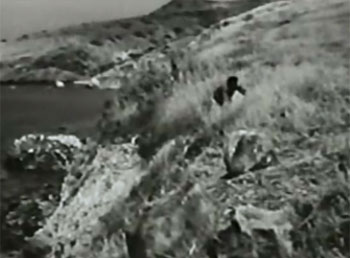

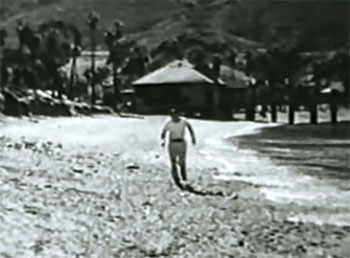
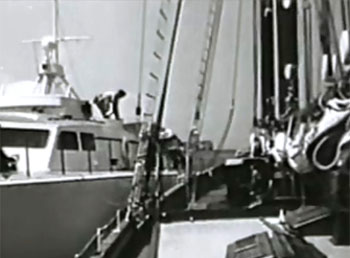
Above: Jack Ingram climbs the Catalina slopes (top left); Buster Crabbe spies on one of the Admiral’s henchmen outside the villain’s manor-bungalow (top right); Crabbe walks along the Catalina beach (bottom left); the Albatross and the Sea Hound pull alongside for a fight (bottom right).
Such settings give visual interest to even the most perfunctory action scenes, although some of the serial’s fights and chases are quite respectable in their own right; directors Mack V. Wright and Walter Eason manage to turn in some good action work despite their low budget–with some help from stuntmen Paul Stader and Wally West and some from cast members, who seem to handle a lot of their own stuntwork. The large-scale gun battle on the beach between the Admiral’s men and the crew of the Esmerelda is excellent; other highlights include the brawl in the bar in Chapter Three (with about six or seven heroes and heavies involved), the fight on the Sea Hound in Chapter Six (with Buster Crabbe chasing a henchman into the rigging), the chase along the beach in Chapter Eight and the subsequent fight, and Crabbe’s nocturnal rescue of Milton Kibbee from the Albatross–one of many scenes in which our star displays his real-life Olympic swimming prowess.
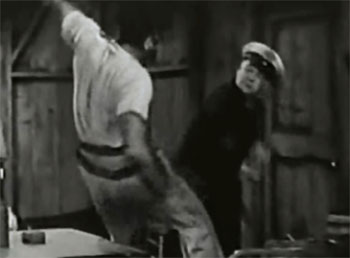
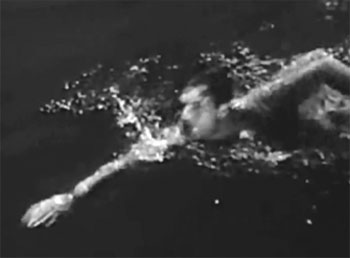
Above left: Stanley Blystone slugs Crabbe (or his double) in a good fight scene in Chapter Four. Above right: Crabbe makes a nighttime swim out to the Albatross.
Other action sequences–the fight in the Admiral’s house in Chapter Five, the chase through the jungle in Chapter Eight–are much briefer and less elaborate, but quite good. However, such scenes are balanced by some decidedly duller ones, like a villainous diver’s lackluster underwater attack on Silver in Chapter Two, or the good guys’ Chapter Five trek along a booby-trapped jungle trail–a sequence that’s supposedly to be suspenseful, but is staged and shot so casually that all tension is successfully extinguished (even a little intercutting between the looming traps and the unsuspecting heroes would have helped here).
Most of the serial’s chapter endings suffer from the same lack of buildup that the trail sequence does; rarely do the writers, directors, or editors attempt a gradual increase of suspense. Instead, a danger abruptly rears its head and the serial cuts to the “next week” preview, often before we’ve even completely realized what’s going on; the explosion of the floating mine at the end of Chapter One and the attack on the heroine by a man-eating plant which concludes Chapter Five are two of the most egregious examples. Even some of the more interesting cliffhangers–like Crabbe and Ralph Hodges’ near-drowning on the Admiral’s tortuous “water wheel”–suffer from this lack of foreshadowing. Perhaps the best chapter ending is the one that has Crabbe plummeting to the ocean from the Sea Hound’s rigging after being shot; though simple in conception, it’s nicely foreshadowed by the dizzying climb to the masthead that preceded it.
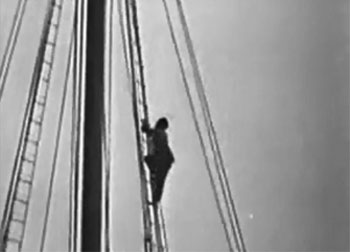
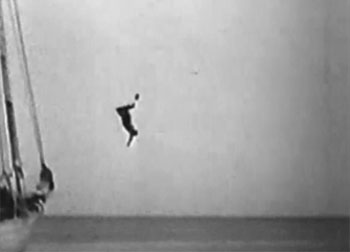
Above: What goes up must come down.
Writers Lewis Clay, Arthur Hoerl, and George H. Plympton aren’t always able to prevent their narrative from spinning its wheels, although they make a gallant effort to keep things interesting. The continual game of three-way cat-and-mouse between Silver, Rand, and the Admiral–who first battle over an important treasure map and then over Professor Whitney–keeps the first two-thirds of the serial moving pretty briskly, helped along by continual trips to and from the Albatross, the Sea Hound, the coastal town, the Admiral’s plantation and “slave camp,” and the jungle. This repetitive tug-of-war starts to wear out its welcome by about the tenth chapter, but the serial doesn’t completely collapse until the last three episodes–in which the action moves permanently away from the coast into the interior, the Ryaks (heretofore depicted as savage and ruthless) suddenly become friendly, and the villains start killing each other with no assistance from the heroes (the sudden and undramatic demise of the Admiral’s bodyguard Singapore is particularly disappointing, since the script continually promises a fight between him and Captain Silver that never comes).
The writers are more successful when it comes to creating interesting and colorful characterizations–the inconsistent depiction of the Ryaks aside. They’re helped in this department, however, by a strong cast, each of whom makes the most of his role. The most preeminent–and the best–of the serial’s performers is Buster Crabbe, who makes his return to the cliffhanger genre (after a seven-year hiatus) with all the assurance, athleticism, and charisma he displayed in his 1930s Universal serials. Slightly gruffer and more down-to-earth (his tough, no-nonsense confrontations with the villains are excellent), Crabbe is still tremendously affable and easy-going when interacting with his friends. His star presence goes a long way towards holding the serial together.

Above, left to right: Fritz the dog, Spencer Chan, Jimmy Lloyd, Ralph Hodges, and Buster Crabbe.
Crabbe’s sidekicks are all very likable as well, lending the proceedings some additional energy with their happy-go-lucky bantering. Ralph Hodges is appealingly cheerful as the impetuous Jerry, while Spencer Chan plays the reserved Kukai with a welcome touch of deadpan humor, particularly when his character is making resourceful use of various electrical gadgets to drive heavies from Silver’s ship. Jimmy Lloyd’s fun-loving, fight-loving Tex is potentially the most interesting of the three sidekicks–but although Lloyd plays the part with energy, his flat Midwestern voice and gruffly down-to-earth demeanor aren’t really suited to the part of a boisterous cowboy (someone like George Chesebro, Hal Taliaferro, or even Charles King would have been a much better fit for the role). Fritz, a small and wooly ship’s dog, makes a fourth sidekick for Crabbe, although his heroics are understandably limited when compared to those of the German Shepherd co-heroes seen in earlier serials.
Robert Barron, usually a supporting heavy, does a fine job in the unusually meaty part of the Admiral. The character is a cynically suave type who enjoys luxuries and personal comfort and prefers to leave crude violence to his henchmen; Barron’s languid but crafty demeanor suits the part admirably. His sarcastically superior interchanges with his scruffy henchmen and his sly negotiations with Buster Crabbe and Hugh Prosser are very well-played. Prosser does a similarly good job with his character; his confidently businesslike manner is very appropriate for his tireless conniver, who’s too self-assured to ever realize he’s getting in over his head. Pierce Lyden, as Prosser’s hard-bitten and more cautious henchman, serves as a sort of cautionary chorus for his boss, and one feels rather sorry for him when Prosser’s schemes drag him to his doom.

Above: Robert Barron, Hugh Prosser, and Pierce Lyden.
Heroine Pamela Blake generally remains in the background, but gives her character enough personality to avoid being overlooked, conveying a quiet but strong determination as she searches for her character’s missing father. Milton Kibbee, as the absent parent, spends much of the serial as a silent and amnesic prisoner of the Ryaks, but has some good scenes later on that reveal his character as likably cunning; I particularly like the deranged laugh he gives when feigning insanity for the Admiral’s benefit.
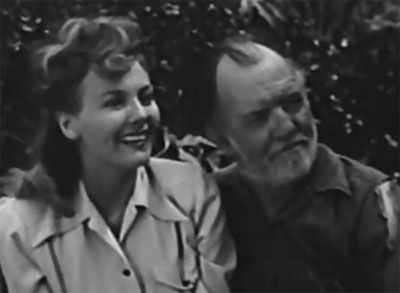
Above: Pamela Blake and Milton Kibbee.
Jack Ingram–as tough, cagey, and cranky as ever–heads up the Admiral’s henchmen. Rusty Wescoatt is memorable as the brutish, thick-witted Singapore, while Rick Vallin–despite the distinctive moniker of “Manila Pete”–has a much less colorful role as Ingram’ s second-in-command. Stanley Blystone, with his harsh voice and burly build, is perfectly cast as Black Mike, the overseer of the Admiral’s slave camp. Bob Duncan has few lines but looks properly sinister as an eye-patched henchman; Al Baffert and Wally West round out the Admiral’s gang.
Harry Vejar is rather hammy as the Ryak chief, while his warriors are played by the same troupe of Samoans who served as natives in many of producer Katzman’s Jungle Jim films. Britt Wood, a former sidekick to William Boyd’s Hopalong Cassidy, is both sleazy and comic as Van Wart, the garrulous proprietor of the island bar who sells information to all sides; Wood’s slow, sleepy voice gives the character an aura of tropics-induced decay. William Fawcett is also colorful as the beachcomber Andre, a less duplicitous peddler of information, although his Gallic accent is passable at best. Gene Roth, who would go on to play major heavies in many later Katzman serials, has a brief bit here as an island store owner, while Delores Castle plays a servant girl at the Admiral’s plantation and Carl LeVinness is a rather pathetic old prospector held prisoner by the Admiral. The performer who plays Britt Wood’s bartender is unfortunately unidentified, but looks a lot like the same unknown (to me) actor that played the henchman Burk in Who’s Guilty.
The Sea Hound is far from a gem, but its cast, characters, leading man, and Catalina locations make it definitely worth a serial buff’s time, and help it to stand apart from utter disappointments of the same era like Who’s Guilty, Son of the Guardsman, or Hop Harrigan.
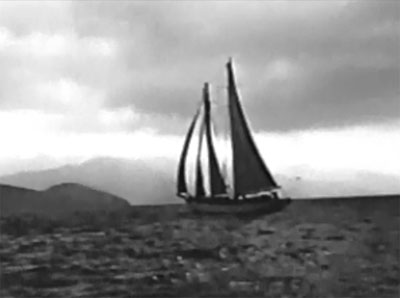
Spot-on review. I think that you really nailed the pluses and minuses of this serial. It makes such a difference having an engaging and likable actor like Buster Crabbe playing the lead. So many of the Katzman productions had bland and boring heroes, much to their detriment. I liked the way Crabbe and Robert Barron played off of each other, and also some of the exchanges between Crabbe and his crew, in particular the ones with Spencer Chan.